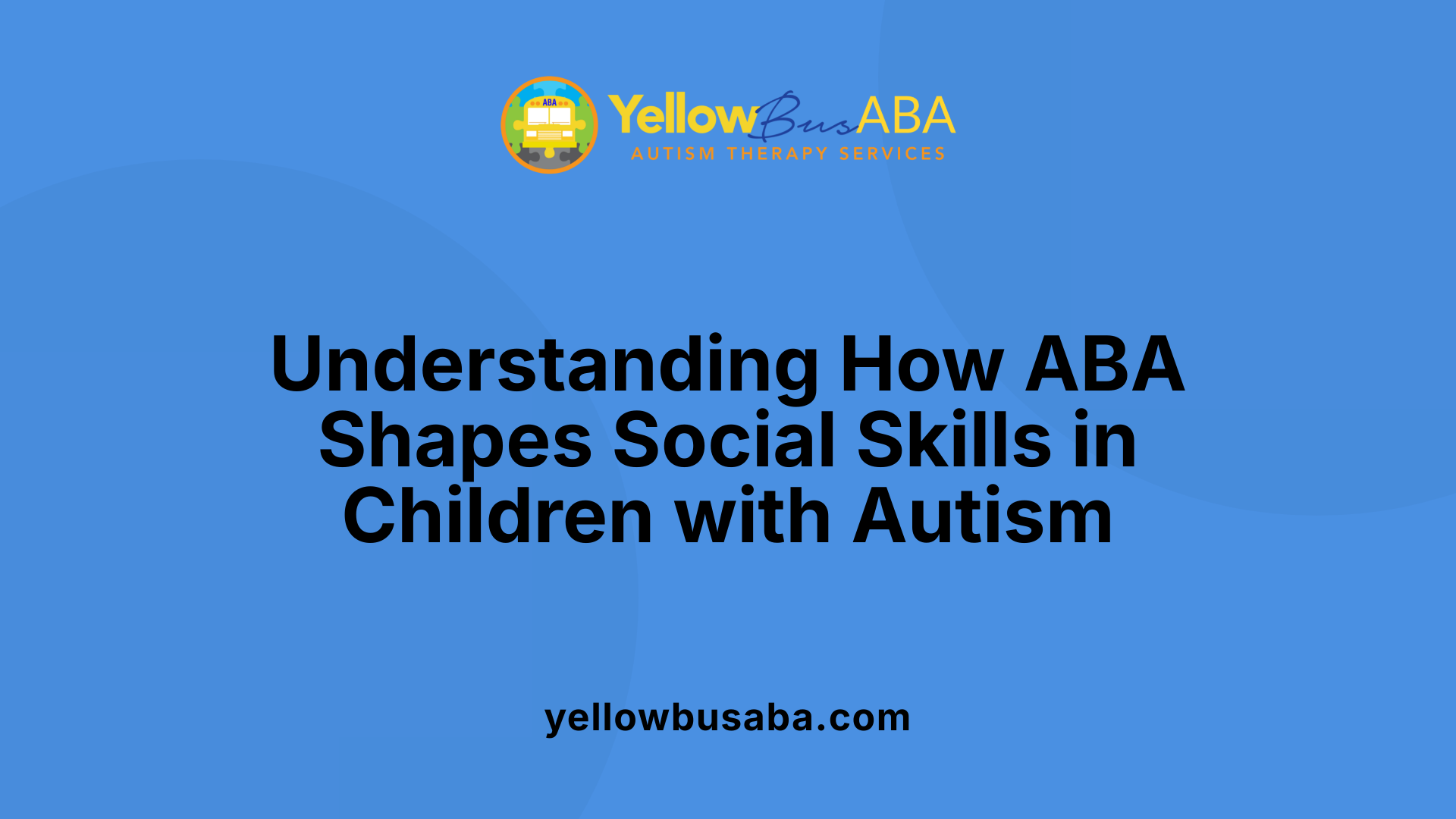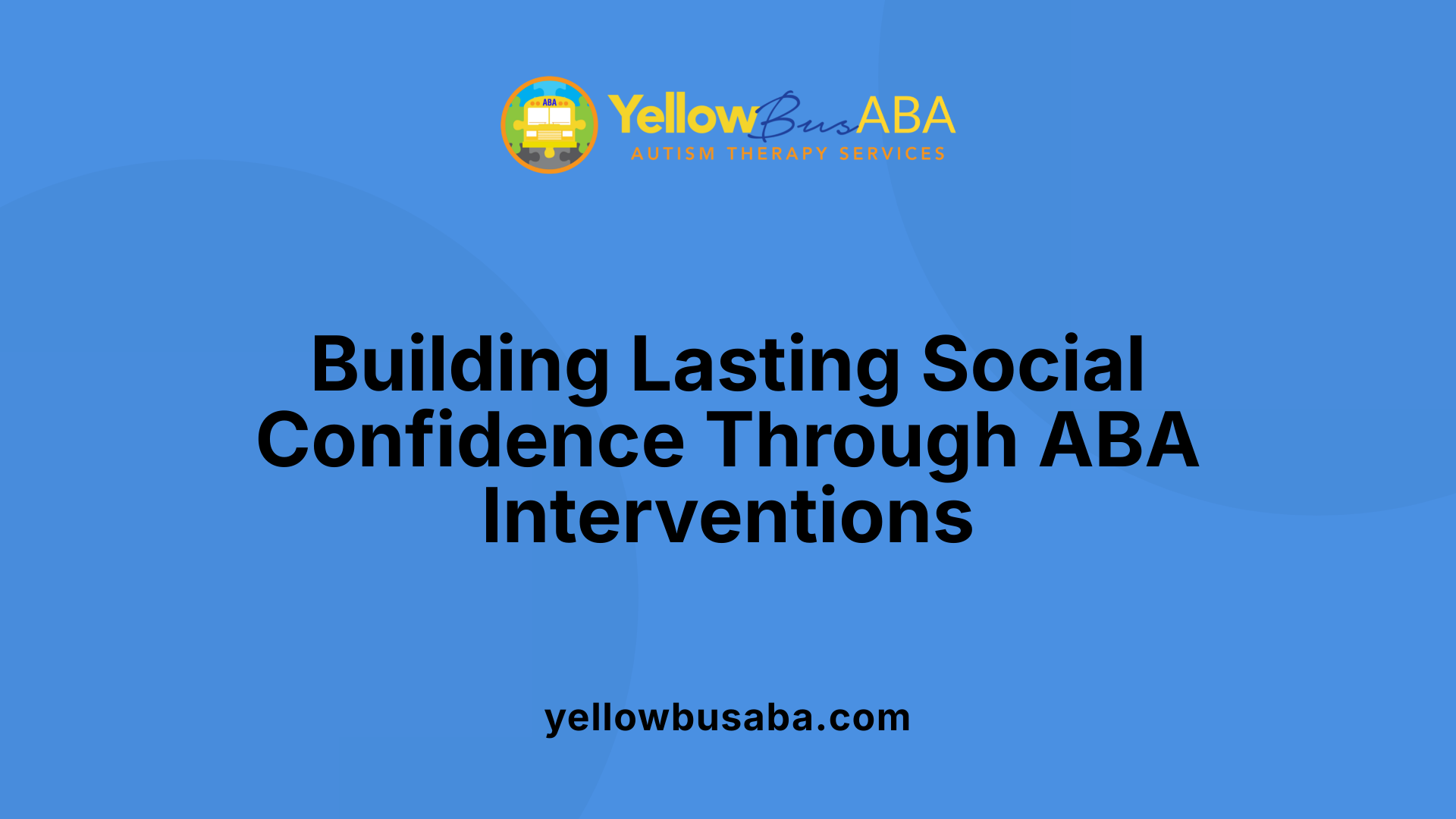Understanding the Impact of ABA on Social Skills Development
Autism Spectrum Disorder (ASD) presents unique challenges in social interaction and communication. Applied Behavior Analysis (ABA) therapy has emerged as a scientifically supported approach to help children with autism recognize and respond to social cues effectively. This article explores how ABA supports social understanding, detailing strategies, real-world applications, and ways caregivers can reinforce these skills.
Foundations of ABA Therapy in Social Skills Development

How does ABA therapy help children with autism understand social cues?
ABA therapy significantly improves how children with autism perceive and interpret social cues. It employs structured teaching methods that focus on recognizing facial expressions, body language, tone of voice, and other social signals.
One effective strategy used is role-playing, where children practice social scenarios like greeting someone or sharing toys. This provides a safe environment to learn appropriate responses.
Social stories are another tool; short narratives explain social situations and expected behaviors, helping children understand what to do in different contexts.
Visual aids, such as picture cards, support children in understanding emotions and social cues, especially for non-verbal or minimally verbal children.
Modeling desired behaviors through observing therapists or peers demonstrates how to initiate conversations or respond to cues, reinforcing learning.
By breaking down complex social skills into small, manageable parts, ABA reduces anxiety and overwhelm that often accompany social interactions.
Repeated practice and positive reinforcement motivate children to apply what they learn, leading to improvements in eye contact, turn-taking, and active listening.
Over time, these targeted interventions help children respond more appropriately, fostering meaningful social relationships and communication skills.
Building Social Skills through Targeted Strategies
 ABA therapy employs several research-backed techniques to help children with autism learn and interpret social cues effectively.
ABA therapy employs several research-backed techniques to help children with autism learn and interpret social cues effectively.
One fundamental approach is task analysis, which involves breaking down complex social interactions into smaller, manageable steps. This makes it easier for children to learn each component of social behavior, such as recognizing facial expressions or understanding tone of voice.
Modeling is another widely used method, where therapists demonstrate desired behaviors, like starting a conversation or responding appropriately to social cues. Children observe these behaviors and then imitate them during sessions.
Role-playing exercises are especially effective, allowing children to rehearse social scenarios in a safe environment. For example, children practice greetings, turn-taking, and sharing, boosting their confidence and response skills.
Social stories and scripts are short, descriptive narratives that explain social expectations and situations. They help children understand what to do in specific contexts, making social understanding clearer.
Visual aids, including picture cards and video modeling, support visual learners by illustrating social cues and appropriate responses. Video modeling, in particular, uses recordings of peers or adults demonstrating social behaviors, allowing children to observe and imitate.
Peer-mediated interventions involve typically developing peers who are trained to support and reinforce social skills. This promotes natural interactions and helps children build friendships.
Together, these strategies are integrated into individualized ABA programs, emphasizing reinforcement and natural environment training. They not only develop social understanding but also foster generalization across different settings, enhancing overall social engagement and quality of life.
The Role of Reinforcement and Positive Feedback

What are positive reinforcement techniques used in ABA therapy?
Positive reinforcement is a central element in ABA therapy. It involves providing children with rewards or praise immediately after they perform a desired behavior. This could include verbal praise, tokens, stickers, or other tangible rewards. The goal is to increase the likelihood that the child will repeat the behavior in the future.
Therapists carefully select reinforcement strategies tailored to each child's preferences, ensuring they find the rewards motivating. As the behavior becomes more consistent, the reinforcement can be gradually faded to promote independence.
How do reward systems enhance learning in therapy?
Reward systems in ABA therapy serve as positive stimuli that reinforce social and communication behaviors. For example, a child who initiates a conversation might receive praise or a token that can be exchanged for a preferred activity.
These reward systems help children associate social behaviors with positive outcomes, encouraging them to practice these skills. Using tokens and charts creates a tangible way for children to track their progress and motivation.
How does reinforcement encourage social behaviors?
Reinforcement makes social behaviors more attractive by rewarding interactions such as making eye contact, sharing, or responding to social cues. Techniques like social praise, rewards, and social tokens motivate children to engage in social interactions.
Role-playing and social stories are often used alongside reinforcement to teach specific social skills in a fun, engaging way. Over time, children learn to recognize social cues like facial expressions or tone of voice and respond appropriately, cemented by consistent positive feedback.
Educational benefits of ABA therapy for children with autism regarding social interactions
ABA therapy provides many educational advantages in social domains. It systematically teaches skills that are essential for meaningful social relationships, including understanding body language, facial expressions, and gestures.
Children learn to make eye contact, take turns in conversations, understand personal space, and recognize emotions through hands-on methods like modeling and role-playing.
Real-life contexts, such as playdates or group activities, are incorporated into therapy to help children generalize learned skills. Skills are broken down into smaller steps through task analysis, making complex social behaviors more manageable.
By practicing these skills in natural settings and receiving consistent positive reinforcement, children build confidence and social competence. This improvement enhances emotional well-being, promotes peer interactions, and helps children develop lasting friendships, leading to a better quality of life.
Overall, ABA therapy not only teaches children with autism vital social skills but also encourages their application in everyday life, fostering independence and emotional resilience.
Improving Eye Contact and Turn-Taking Skills

How does ABA therapy help children with autism understand social cues?
ABA therapy is highly effective in teaching children with autism to interpret social cues. It employs methods like role-playing, social stories, visual aids such as picture cards, and modeling to help children recognize facial expressions, body language, and vocal tones. By breaking down complex social interactions into smaller, manageable steps, ABA provides structured learning opportunities.
Repeated practice combined with positive reinforcement encourages children to identify emotions, understand social expectations, and respond appropriately. These targeted strategies support the development of essential social skills like eye contact and listening, which are fundamental for meaningful interactions.
ABA therapy also emphasizes gradual exposure to social scenarios, teaching children to initiate conversations, maintain eye contact, and take turns in conversations. Over time, children learn to interpret cues more accurately, building confidence and improving their ability to connect with others.
By fostering these skills, ABA not only enhances social understanding but also helps children develop stronger relationships, contributing to improved social integration and overall quality of life.
Teaching Body Language and Facial Expressions

How can caregivers support an autistic child's understanding of social cues?
Supporting an autistic child's understanding of social cues involves a combination of explicit teaching methods and consistent practice. Caregivers can use visual supports such as picture cards, social stories, and visual schedules to help children recognize facial expressions, gestures, and tone of voice. These tools make abstract social cues more concrete and understandable.
Role-playing exercises are also very effective. In these activities, children practice interpreting and responding to social cues in a controlled setting. For example, demonstrating different facial expressions or practicing greetings can build confidence and skill.
Breaking down social skills into smaller, manageable steps allows children to learn gradually. Repeated practice with reinforcement helps solidify understanding.
Utilizing visual aids like social scripts or cue cards guides children through expected behaviors and responses. Attending structured social skills groups or participating in community activities provide valuable opportunities for real-life practice.
Early intervention, especially through therapies like ABA, enhances the child's ability to recognize and interpret social signals, leading to better social interactions and confidence. Collaborating with professionals and incorporating these strategies into daily routines can significantly improve a child's understanding of body language and facial expressions.
Peer and Community Engagement in Social Skills Training

What strategies are used in ABA therapy to teach social cues to children with autism?
ABA therapy applies a range of methods to help children with autism recognize and respond to social cues effectively. To start, therapists often break down complex social skills into smaller, manageable steps through a process known as task analysis. This systematic approach makes learning easier and more structured.
To demonstrate desired behaviors, modeling is widely used. Children watch and imitate social actions such as initiating conversations, sharing, or making eye contact. Alongside modeling, social stories—short, descriptive narratives—explain social situations and appropriate responses, helping children understand expected behaviors.
Video modeling provides visual learners the chance to observe social skills being performed in real-life contexts, reinforcing understanding and imitation. Peer-mediated interventions involve training typically developing peers to support and encourage social interactions, promoting naturalistic play and friendship building.
Positive reinforcement remains fundamental—children receive praise, tokens, or other rewards for demonstrating social cues like recognizing facial expressions or maintaining eye contact. Therapists also utilize natural environment training, practicing skills in settings like playgrounds or family events to ensure skills transfer to daily life.
Overall, ABA combines these strategies within tailored programs designed to enhance social cognition, facilitate meaningful interactions, and build lasting social skills.
How do group sessions and natural environment training contribute to social skills development?
Group social skills sessions offer children opportunities to practice interacting with peers in structured settings. Through games, role-playing, and collaborative activities, kids learn turn-taking, sharing, and recognizing social signals. These sessions foster a sense of community and help children build friendships while honing their social skills.
Natural environment training (NET) takes place in settings where children naturally encounter social cues, such as during family outings, school activities, or playdates. This real-world practice helps children generalize skills beyond the therapy room, applying what they learn in familiar environments.
Both approaches support social development by providing authentic opportunities for children to interpret cues, respond appropriately, and experience positive social interactions. When combined, group sessions and NET create comprehensive frameworks that boost confidence and improve social functioning in everyday life.
How can parents and caregivers support social skills at home?
Parents and caregivers play a crucial role in reinforcing social skills learned during ABA therapy. They can incorporate routines, games, and activities that promote social interactions, such as role-playing conversations, sharing stories, or practicing greetings. Positive reinforcement, such as praise or small rewards, motivates children to use social cues correctly.
Establishing visual supports like picture schedules or social stories at home can also guide children through social scenarios, making expectations clearer. Collaboration with therapists ensures consistency and tailored support, helping children translate skills from therapy to home and community settings.
By creating a supportive environment and encouraging naturalistic social practice, families can significantly enhance the child's social understanding and confidence, leading to more meaningful interactions and friendships.
Long-term Outcomes and Social Confidence

What are the educational benefits of ABA therapy for children with autism regarding social interactions?
ABA therapy offers significant educational advantages that help children with autism develop vital social skills critical for everyday life.
One of its main strengths is teaching foundational social behaviors such as making eye contact, taking turns during conversations or play, understanding personal space, and recognizing others' emotions. These skills create a base for building meaningful relationships and engaging effectively with peers.
ABA uses a variety of training methods that are directly applicable to real-world settings. For example, children practice these skills through role-playing exercises, where they rehearse greeting people or sharing toys. Visual aids like picture cards also help children interpret social cues and respond appropriately.
The therapy emphasizes naturalistic learning environments, encouraging children to transfer skills from therapy sessions to parks, classrooms, and group activities. This approach helps children gain confidence in social situations by gradually increasing the complexity of tasks.
Strategies such as modeling desired behaviors, positive reinforcement, and social skills groups are systematically employed to foster behaviors like cooperative play, initiating conversations, and understanding social boundaries.
Consequently, children not only improve their immediate social skills but also develop a better understanding of social dynamics, which is crucial for ongoing personal and educational growth.
Impact on Social Confidence Developing these skills boosts children's confidence in social settings. As they become more adept at interpreting cues like facial expressions and tone of voice, children feel more comfortable navigating social interactions.
This increased confidence often leads to greater participation in group activities and friendships, fostering a sense of belonging and emotional well-being.
Long-lasting Social Skills The social skills acquired through ABA are durable because they are taught through consistent practice and reinforced in multiple settings. Children learn to generalize these skills to various environments, making their social competence sustainable.
In the long term, this foundational skill set enhances the child's ability to maintain friendships, cooperate in team settings, and participate meaningfully in community life, significantly improving their quality of life.
Collaborating with Families and Professionals for Social Success

How can caregivers support an autistic child's understanding of social cues?
Caregivers play a crucial role in helping children with autism recognize and interpret social cues. They can do this by providing explicit teaching using visual supports such as picture cards, social stories, and visual scripts. These tools help make social situations more predictable and understandable.
Role-playing exercises are also effective. Through practicing interactions like greetings, sharing, or taking turns, children learn appropriate responses in a controlled, supportive environment.
Breaking down complex social skills into small, manageable steps and practicing them consistently reinforces learning. For example, caregivers might focus on teaching a child to recognize facial expressions or respond to tone of voice separately before combining these skills.
Engaging children in structured social skills groups or community activities provides real-life practice. These settings allow children to apply their skills in situations that mirror daily life, strengthening their social competence.
Early intervention with professional support, such as ABA therapy, enhances progress by systematically teaching social cues and behaviors. This approach not only improves social understanding but also boosts confidence and independence.
Parents and caregivers are encouraged to collaborate closely with therapists and educators to create consistent routines and reinforcement strategies at home. This teamwork ensures the child continually practices and applies social skills across different environments, leading to meaningful development and better social participation.
Fostering Meaningful Social Connections with ABA
In summary, ABA therapy plays a vital role in supporting children with autism to understand, interpret, and respond appropriately to social cues. By employing a comprehensive set of strategies—including modeling, role-playing, social stories, and reinforcement—therapists work collaboratively with families to develop essential social skills. Early diagnosis and intervention reinforce positive outcomes, allowing children to build confidence, form friendships, and thrive in various social environments. The long-lasting benefits of targeted ABA interventions emphasize the importance of continued support, education, and community involvement in nurturing social development and enriching the quality of life for children with autism.
References
- How ABA Therapy Supports Children with Autism
- How ABA Therapy Improves Social Cues Recognition in Children
- How ABA Therapy Enhances Social Skills in Children with ASD
- Understanding Social Cues: A Quick Start Guide for Autism
- How ABA Therapy Helps Improve Social Skills in Children
- Understanding Social Cues: A Quick Start Guide for Autism
- Social skills and autism | Autism Speaks
- Autism and Social Cues: Understanding the Challenges





.jpg)
